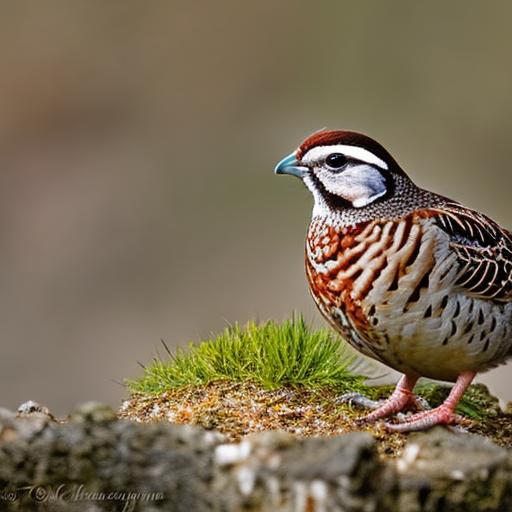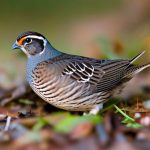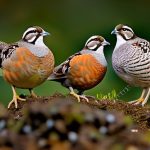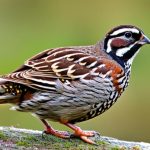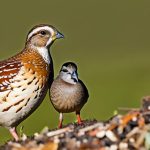When it comes to choosing the right aviary for quail, there are a few key factors to consider. First and foremost, the size of the aviary is crucial. Quail need plenty of space to move around and exhibit natural behaviors, so it’s important to provide them with a spacious environment. Additionally, the material of the aviary is important. It should be sturdy and secure to protect the quail from predators and the elements.
Another important consideration when choosing an aviary for quail is the design and layout. Quail are ground-dwelling birds, so the aviary should have plenty of ground space for them to forage and dust bathe. It’s also important to provide them with areas for cover and shelter, such as shrubs or small trees. Additionally, the aviary should have a secure roof to protect the quail from aerial predators. Overall, the key to choosing the right aviary for quail is to prioritize their natural behaviors and provide them with a safe and comfortable environment.
When selecting an aviary for quail, it is essential to consider the size and material of the enclosure. Quail require ample space to move around and exhibit natural behaviors, so a spacious environment is crucial. The material of the aviary should be durable and secure to protect the quail from predators and the elements. Additionally, the design and layout of the aviary are important factors to consider. Quail are ground-dwelling birds, so the aviary should have plenty of ground space for foraging and dust bathing. It’s also important to provide areas for cover and shelter, such as shrubs or small trees, as well as a secure roof to protect the quail from aerial predators. Ultimately, choosing the right aviary for quail involves prioritizing their natural behaviors and providing a safe and comfortable environment.
Key Takeaways
- Choose an aviary with adequate space and protection from predators for quail
- Provide a diet high in protein and essential nutrients for quail in an aviary
- Create a comfortable environment with proper bedding, temperature, and lighting for quail in an aviary
- Regularly monitor and maintain the health of quail in an aviary to prevent diseases and injuries
- Encourage natural behaviors such as dust bathing and foraging in quail in an aviary
- Follow proper breeding and raising practices to ensure the well-being of quail in an aviary
- Interact with and enjoy the company of quail in an aviary to build a strong bond and observe their natural behaviors
Providing the Proper Diet for Quail in an Aviary
In order to ensure the health and well-being of quail in an aviary, it is crucial to provide them with a proper diet. Quail are omnivorous birds, so their diet should consist of a variety of foods including seeds, grains, insects, and green vegetation. A high-quality game bird feed can serve as the foundation of their diet, providing essential nutrients and vitamins. Additionally, offering a mix of seeds such as millet, sunflower seeds, and cracked corn can help mimic their natural foraging behavior.
In addition to seeds and grains, quail should also have access to live insects such as mealworms or crickets, which are rich in protein and essential for their overall health. Green vegetation such as leafy greens and grass can also be offered to provide additional nutrients and enrichment. It’s important to monitor their diet and make adjustments as needed based on their activity level, breeding status, and overall health. By providing a well-rounded and varied diet, quail in an aviary can thrive and exhibit natural behaviors.
To ensure the health and well-being of quail in an aviary, it is essential to provide them with a proper diet. As omnivorous birds, quail require a variety of foods including seeds, grains, insects, and green vegetation. A high-quality game bird feed can serve as the foundation of their diet, providing essential nutrients and vitamins. Additionally, offering a mix of seeds such as millet, sunflower seeds, and cracked corn can help mimic their natural foraging behavior. In addition to seeds and grains, quail should also have access to live insects such as mealworms or crickets, which are rich in protein and essential for their overall health. Green vegetation such as leafy greens and grass can also be offered to provide additional nutrients and enrichment. It’s important to monitor their diet and make adjustments as needed based on their activity level, breeding status, and overall health. By providing a well-rounded and varied diet, quail in an aviary can thrive and exhibit natural behaviors.
Creating the Ideal Environment for Quail in an Aviary
Creating the ideal environment for quail in an aviary involves providing them with the necessary elements to exhibit natural behaviors and thrive. One key aspect of the environment is substrate. Quail benefit from having access to a natural substrate such as sand or soil, which allows them to dust bathe and forage for insects. Additionally, providing them with areas of cover such as shrubs or small trees can help create a more naturalistic environment and give them a sense of security.
Another important element of the environment is enrichment. Quail are active birds that require mental stimulation, so providing them with items such as perches, branches, or hanging toys can help keep them engaged and prevent boredom. It’s also important to consider the temperature and lighting in the aviary. Quail are sensitive to extreme temperatures, so it’s important to provide them with adequate ventilation and shade during hot weather, as well as protection from drafts during colder months. By creating an environment that meets their physical and behavioral needs, quail in an aviary can lead healthy and fulfilling lives.
Creating the ideal environment for quail in an aviary involves providing them with the necessary elements to exhibit natural behaviors and thrive. One key aspect of the environment is substrate. Quail benefit from having access to a natural substrate such as sand or soil, which allows them to dust bathe and forage for insects. Additionally, providing them with areas of cover such as shrubs or small trees can help create a more naturalistic environment and give them a sense of security. Another important element of the environment is enrichment. Quail are active birds that require mental stimulation, so providing them with items such as perches, branches, or hanging toys can help keep them engaged and prevent boredom. It’s also important to consider the temperature and lighting in the aviary. Quail are sensitive to extreme temperatures, so it’s important to provide them with adequate ventilation and shade during hot weather, as well as protection from drafts during colder months. By creating an environment that meets their physical and behavioral needs, quail in an aviary can lead healthy and fulfilling lives.
Ensuring the Health and Safety of Quail in an Aviary
Ensuring the health and safety of quail in an aviary is paramount for their overall well-being. One key aspect of this is predator control. Aviaries should be constructed with secure fencing and roofing to prevent access from predators such as cats, dogs, raccoons, or birds of prey. Additionally, it’s important to regularly inspect the aviary for any potential weak spots or breaches that could compromise its security.
Another important factor in ensuring the health of quail in an aviary is disease prevention. Aviaries should be kept clean and free from standing water or damp areas that could harbor bacteria or parasites. Regular cleaning of feeders and waterers is also essential to prevent contamination. It’s also important to monitor the quail for any signs of illness or injury and seek veterinary care when necessary.
In addition to predator control and disease prevention, providing proper nutrition is crucial for maintaining the health of quail in an aviary. A balanced diet that meets their nutritional needs is essential for their overall well-being. By taking proactive measures to ensure their health and safety, quail in an aviary can thrive and lead fulfilling lives.
Ensuring the health and safety of quail in an aviary is paramount for their overall well-being. Predator control is a key aspect of this, as aviaries should be constructed with secure fencing and roofing to prevent access from predators such as cats, dogs, raccoons, or birds of prey. Additionally, it’s important to regularly inspect the aviary for any potential weak spots or breaches that could compromise its security.
Another important factor in ensuring the health of quail in an aviary is disease prevention. Aviaries should be kept clean and free from standing water or damp areas that could harbor bacteria or parasites. Regular cleaning of feeders and waterers is also essential to prevent contamination. It’s also important to monitor the quail for any signs of illness or injury and seek veterinary care when necessary.
In addition to predator control and disease prevention, providing proper nutrition is crucial for maintaining the health of quail in an aviary. A balanced diet that meets their nutritional needs is essential for their overall well-being. By taking proactive measures to ensure their health and safety, quail in an aviary can thrive and lead fulfilling lives.
Encouraging Natural Behaviors in Quail in an Aviary
Encouraging natural behaviors in quail in an aviary is essential for their physical and mental well-being. One way to achieve this is by providing them with opportunities for foraging. Scatter feeding or using puzzle feeders can help mimic their natural behavior of searching for food on the ground. Additionally, offering live insects such as mealworms or crickets can provide them with enrichment while allowing them to exhibit hunting behaviors.
Another important natural behavior for quail is dust bathing. Providing them with a shallow tray filled with sand or dusting material allows them to engage in this instinctive behavior, which helps keep their feathers clean and free from parasites.
In addition to foraging and dust bathing, providing areas of cover such as shrubs or small trees allows quail to exhibit natural behaviors such as nesting and seeking shelter. By creating an environment that encourages these natural behaviors, quail in an aviary can lead fulfilling lives.
Encouraging natural behaviors in quail in an aviary is essential for their physical and mental well-being. One way to achieve this is by providing them with opportunities for foraging. Scatter feeding or using puzzle feeders can help mimic their natural behavior of searching for food on the ground. Additionally, offering live insects such as mealworms or crickets can provide them with enrichment while allowing them to exhibit hunting behaviors.
Another important natural behavior for quail is dust bathing. Providing them with a shallow tray filled with sand or dusting material allows them to engage in this instinctive behavior, which helps keep their feathers clean and free from parasites.
In addition to foraging and dust bathing, providing areas of cover such as shrubs or small trees allows quail to exhibit natural behaviors such as nesting and seeking shelter. By creating an environment that encourages these natural behaviors, quail in an aviary can lead fulfilling lives.
Breeding and Raising Quail in an Aviary
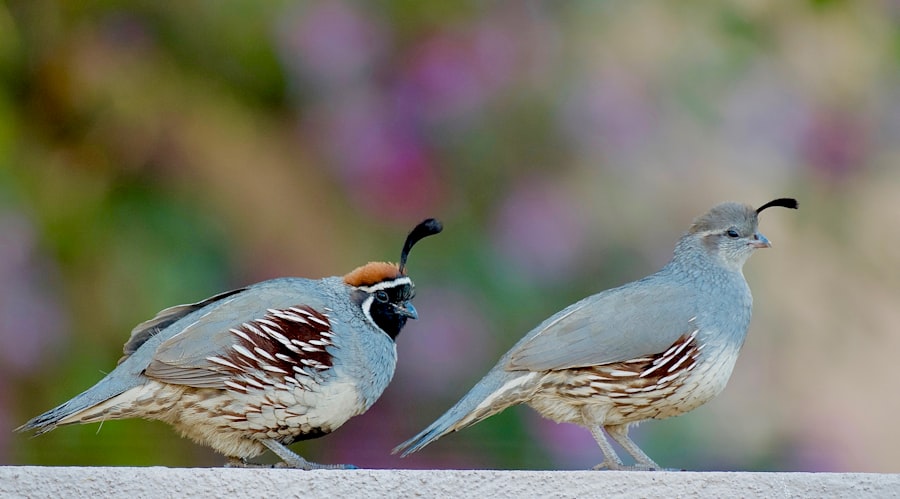
Breeding and raising quail in an aviary requires careful planning and attention to detail. One key consideration is providing suitable nesting sites for breeding pairs. Nesting boxes filled with soft bedding material such as straw or hay can provide a safe and comfortable environment for laying eggs.
Once eggs are laid, it’s important to monitor them closely for signs of fertility and development. Incubating fertile eggs in a separate hatcher can increase hatch rates while providing optimal conditions for embryonic development.
After hatching, raising young quail requires special care including providing a heat source such as a brooder lamp, offering a high-protein starter feed, and ensuring access to clean water at all times.
By taking these steps to create a suitable breeding environment and providing proper care for young quail, breeders can successfully raise healthy offspring in an aviary setting.
Breeding and raising quail in an aviary requires careful planning and attention to detail. One key consideration is providing suitable nesting sites for breeding pairs. Nesting boxes filled with soft bedding material such as straw or hay can provide a safe and comfortable environment for laying eggs.
Once eggs are laid, it’s important to monitor them closely for signs of fertility and development. Incubating fertile eggs in a separate hatcher can increase hatch rates while providing optimal conditions for embryonic development.
After hatching, raising young quail requires special care including providing a heat source such as a brooder lamp, offering a high-protein starter feed, and ensuring access to clean water at all times.
By taking these steps to create a suitable breeding environment and providing proper care for young quail, breeders can successfully raise healthy offspring in an aviary setting.
Interacting with and Enjoying Quail in an Aviary
Interacting with quail in an aviary can be a rewarding experience for bird enthusiasts. While quail may not be as interactive as some other bird species, they can still be observed engaging in natural behaviors such as foraging, dust bathing, or socializing with other members of their flock.
One way to interact with quail is by providing them with treats such as mealworms or fresh greens by hand. This can help build trust between the birds and their caretakers while allowing for closer observation of their behavior.
Additionally, spending time observing quail in their natural habitat within the aviary can be a relaxing way to connect with nature while appreciating these unique birds.
Overall, interacting with quail in an aviary provides an opportunity to observe their natural behaviors while fostering a deeper appreciation for these fascinating birds.
Interacting with quail in an aviary can be a rewarding experience for bird enthusiasts. While quail may not be as interactive as some other bird species, they can still be observed engaging in natural behaviors such as foraging, dust bathing, or socializing with other members of their flock.
One way to interact with quail is by providing them with treats such as mealworms or fresh greens by hand. This can help build trust between the birds and their caretakers while allowing for closer observation of their behavior.
Additionally, spending time observing quail in their natural habitat within the aviary can be a relaxing way to connect with nature while appreciating these unique birds.
Overall, interacting with quail in an aviary provides an opportunity to observe their natural behaviors while fostering a deeper appreciation for these fascinating birds.
Observing quail in an aviary allows for a firsthand look at their social interactions, foraging behaviors, and unique vocalizations. This experience can help people gain a better understanding of the important role quail play in their ecosystems and the challenges they face in the wild. Additionally, spending time in an aviary can create a sense of connection with these birds and inspire a desire to support conservation efforts to protect their habitats. Overall, interacting with quail in an aviary provides an enriching and educational experience that can lead to a greater appreciation for these captivating creatures.
If you’re interested in keeping quail in an aviary, you may also want to explore the article on “Chicken Coop Portage” from Poultry Wizard. This informative piece provides valuable insights into creating a comfortable and secure living space for chickens, which can offer useful tips for designing an aviary for quail as well. Check it out here.
FAQs
What is an aviary?
An aviary is a large enclosure for keeping birds. It is typically larger than a cage and allows birds to fly and move around more freely.
Can quail be kept in an aviary?
Yes, quail can be kept in an aviary as long as the enclosure is secure and provides the necessary space and amenities for the quail to thrive.
What are the benefits of keeping quail in an aviary?
Keeping quail in an aviary allows them to exhibit more natural behaviors, such as flying and foraging. It also provides a more spacious and enriching environment for the quail.
What should be considered when setting up an aviary for quail?
When setting up an aviary for quail, it is important to ensure that the enclosure is secure, provides adequate space for the quail to move around, and includes appropriate shelter, perches, and nesting areas.
What do quail need in their aviary?
Quail in an aviary need access to food and water, shelter from the elements and predators, places to perch and nest, and space to move around and exhibit natural behaviors.
What should be included in a quail’s diet in an aviary?
A quail’s diet in an aviary should consist of a balanced commercial quail feed, supplemented with fresh greens, insects, and grit for digestion.
How can the aviary be kept clean for quail?
Regular cleaning and maintenance of the aviary, including removing droppings, replacing bedding, and keeping food and water sources clean, is essential for the health and well-being of quail in an aviary.
Meet Walter, the feathered-friend fanatic of Florida! Nestled in the sunshine state, Walter struts through life with his feathered companions, clucking his way to happiness. With a coop that’s fancier than a five-star hotel, he’s the Don Juan of the chicken world. When he’s not teaching his hens to do the cha-cha, you’ll find him in a heated debate with his prized rooster, Sir Clucks-a-Lot. Walter’s poultry passion is no yolk; he’s the sunny-side-up guy you never knew you needed in your flock of friends!

